-
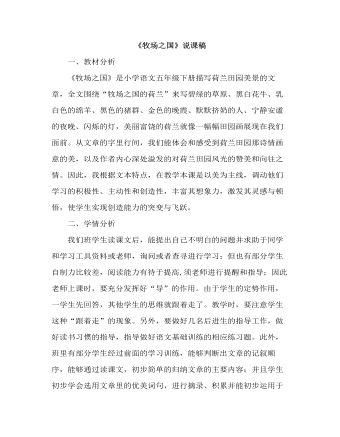
部编人教版五年级下册《牧场之国》说课稿
一、教材分析《牧场之国》是小学语文五年级下册描写荷兰田园美景的文章,全文围绕“牧场之国的荷兰”来写碧绿的草原、黑白花牛、乳白色的绵羊、黑色的猪群、金色的晚霞、默默挤奶的人、宁静安谧的夜晚、闪烁的灯,美丽富饶的荷兰就像一幅幅田园画展现在我们面前。从文章的字里行间,我们能体会和感受到荷兰田园那诗情画意的美,以及作者内心深处溢发的对荷兰田园风光的赞美和向往之情。因此,我根据文本特点,在教学本课是以美为主线,调动他们学习的积极性、主动性和创造性,丰富其想象力,激发其灵感与顿悟,使学生实现创造能力的突变与飞跃。三、目标设计依据四年级儿童特点和教材特色,本着“学语文、用语文”的课研精神,我把《牧场之国》的教学目标确定为:1.通过正确、流利地朗读课文,了解荷兰牧场的特点,感受异国的田园风光。2.通过小组合作提高学生感悟文章语言的生动性,积累语言的能力。
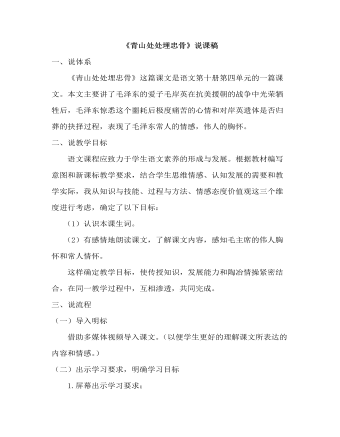
部编人教版五年级下册《青山处处埋忠骨》说课稿
一、说体系《青山处处埋忠骨》这篇课文是语文第十册第四单元的一篇课文。本文主要讲了毛泽东的爱子毛岸英在抗美援朝的战争中光荣牺牲后,毛泽东惊悉这个噩耗后极度痛苦的心情和对岸英遗体是否归葬的抉择过程,表现了毛泽东常人的情感,伟人的胸怀。二、说教学目标语文课程应致力于学生语文素养的形成与发展。根据教材编写意图和新课标教学要求,结合学生思维情感、认知发展的需要和教学实际,我从知识与技能、过程与方法、情感态度价值观这三个维度进行考虑,确定了以下目标:(1)认识本课生词。(2)有感情地朗读课文,了解课文内容,感知毛主席的伟人胸怀和常人情怀。这样确定教学目标,使传授知识,发展能力和陶冶情操紧密结合,在同一教学过程中,互相渗透,共同完成。
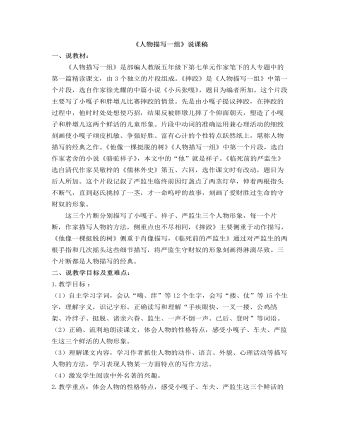
部编人教版五年级下册《人物描写一组》说课稿
二、说教学目标及重难点:1.教学目标 :(1)自主学习字词,会认“噶、绊”等12个生字,会写“搂、仗”等15个生字,理解字义,识记字形。正确读写和理解“手疾眼快、一叉一搂、公鸡鹐架、冷绊子、挺脱、诸亲六眷、监生、一声不倒一声、已后、登时”等词语。(2)正确、流利地朗读课文,体会人物的性格特点,感受小嘎子、车夫、严监生这三个鲜活的人物形象。(3)理解课文内容,学习作者抓住人物的动作、语言、外貌、心理活动等描写人物的方法,学习表现人物某一方面特点的写作方法。(4)激发学生阅读中外名著的兴趣。2.教学重点:体会人物的性格特点,感受小嘎子、车夫、严监生这三个鲜活的人物形象。3.教学难点:学习作者抓住人物的动作、语言、外貌、心理活动等描写人物的方法,学习表现人物某一方面特点的写作方法。
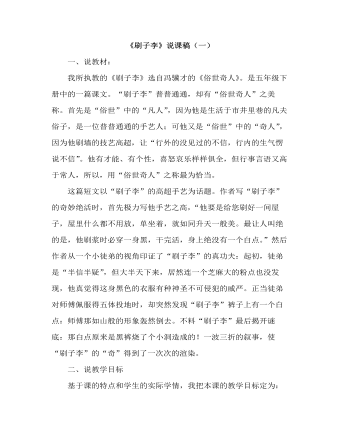
部编人教版五年级下册《刷子李》说课稿(一)
一、说教材:我所执教的《刷子李》选自冯骥才的《俗世奇人》。是五年级下册中的一篇课文。“刷子李”普普通通,却有“俗世奇人”之美称。首先是“俗世”中的“凡人”,因为他是生活于市井里巷的凡夫俗子,是一位普普通通的手艺人;可他又是“俗世”中的“奇人”,因为他刷墙的技艺高超,让“行外的没见过的不信,行内的生气愣说不信”。他有才能、有个性,喜怒哀乐样样俱全,但行事言语又高于常人,所以,用“俗世奇人”之称最为恰当。这篇短文以“刷子李”的高超手艺为话题。作者写“刷子李”的奇妙绝活时,首先极力写他手艺之高,“他要是给您刷好一间屋子,屋里什么都不用放,单坐着,就如同升天一般美。最让人叫绝的是,他刷浆时必穿一身黑,干完活,身上绝没有一个白点。”然后作者从一个小徒弟的视角印证了“刷子李”的真功夫:起初,徒弟是“半信半疑”,但大半天下来,居然连一个芝麻大的粉点也没发现,他真觉得这身黑色的衣服有种神圣不可侵犯的威严。
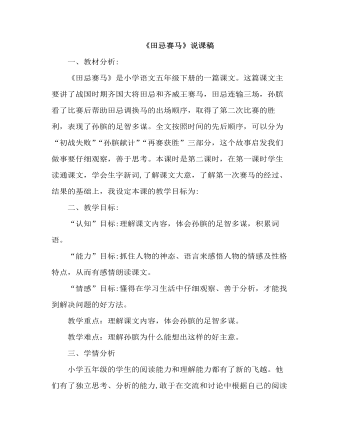
部编人教版五年级下册《田忌赛马》说课稿
一、教材分析:《田忌赛马》是小学语文五年级下册的一篇课文。这篇课文主要讲了战国时期齐国大将田忌和齐威王赛马,田忌连输三场,孙膑看了比赛后帮助田忌调换马的出场顺序,取得了第二次比赛的胜利,表现了孙膑的足智多谋。全文按照时间的先后顺序,可以分为“初战失败”“孙膑献计”“再赛获胜”三部分,这个故事启发我们做事要仔细观察,善于思考。本课时是第二课时,在第一课时学生读通课文,学会生字新词,了解课文大意,了解第一次赛马的经过、结果的基础上,我设定本课的教学目标为:二、教学目标:“认知”目标:理解课文内容,体会孙膑的足智多谋,积累词语。“能力”目标:抓住人物的神态、语言来感悟人物的情感及性格特点,从而有感情朗读课文。“情感”目标:懂得在学习生活中仔细观察、善于分析,才能找到解决问题的好方法。教学重点:理解课文内容,体会孙膑的足智多谋。教学难点:理解孙膑为什么能想出这样的好主意。
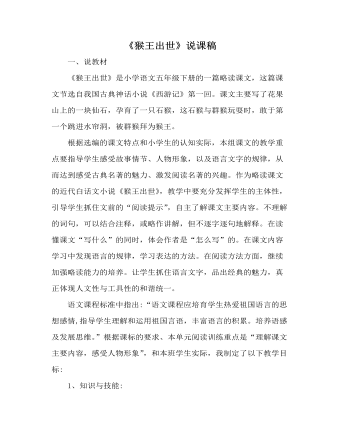
部编人教版五年级下册《猴王出世》说课稿
一、说教材《猴王出世》是小学语文五年级下册的一篇略读课文,这篇课文节选自我国古典神话小说《西游记》第一回。课文主要写了花果山上的一块仙石,孕育了一只石猴,这石猴与群猴玩耍时,敢于第一个跳进水帘洞,被群猴拜为猴王。根据选编的课文特点和小学生的认知实际,本组课文的教学重点要指导学生感受故事情节、人物形象,以及语言文字的规律,从而达到感受古典名著的魅力、激发阅读名著的兴趣。作为略读课文的近代白话文小说《猴王出世》,教学中要充分发挥学生的主体性,引导学生抓住文前的“阅读提示”,自主了解课文主要内容。不理解的词句,可以结合注释,或略作讲解,但不逐字逐句地解释。在读懂课文“写什么”的同时,体会作者是“怎么写”的。在课文内容学习中发现语言的规律,学习表达的方法。在阅读方法方面,继续加强略读能力的培养。让学生抓住语言文字,品出经典的魅力,真正体现人文性与工具性的和谐统一。
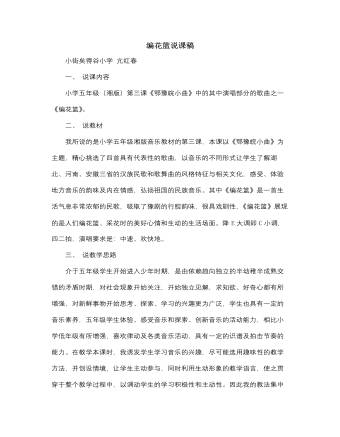
人音版小学音乐五年级下册编花篮说课稿
歌词学习先让学生根据录音模仿学唱,体会河南民歌的韵味,然后跟琴唱,唱时特别要注意前倚音、衬词的运用以及结尾“哪哈依呀咳”“哎”带有豫剧的润腔。这里可多练习几遍,由教师范唱学生模唱以及学生范唱学生模唱的多样化形式激发起学生学唱的兴趣。在唱时歌曲的七、八小节和九、十小节,由于歌词是相同的,学生不注意就会唱成同一旋律,因而,教师在教学时应当作特别的强调,同时这也是教学中的一个难点。(6) 歌曲表现这里我所采用的是全班参与,先是在演唱时各自边唱边做动作,然后教师结合学生的动作作动作创连(操作时要注意考虑学生积极性,主动性,引导学生克服害羞及胆怯的心理)。七、 结束本节课以小组接唱的方式来结束全课,这体现了《新课标》理念中的重视音乐实践和面向全体学生的要求。八、 扩展让学生找找自己喜欢的民族歌曲,查阅其相关背景并有感情的表现出来(注意其地方特色)。

北师大初中七年级数学上册第二章复习教案
. 一个数的倒数等于它本身的数是()A.1 B. C.±1 D.04. 下列判断错误的是()A.任何数的绝对值一定是非负数; B.一个负数的绝对值一定是正数;C.一个正数的绝对值一定是正数; D.一个数不是正数就是负数;5. 有理数a、b、c在数轴上的位置如图所示则下列结论正确的是()A.a>b>0>c B.b>0>a>cC.b<a<0< D.a<b<c<06.两个有理数的和是正数,积是负数,则这两个有理数( )A.都是正数; B.都是负数; C.一正一负,且正数的绝对值较大; D.一正一负,且负数的绝对值较大。7.若│a│=8,│b│=5,且a + b>0,那么a-b的值是( )A.3或13 B.13或-13 C.3或-3 D.-3或-138. 大于-1999而小于2000的所有整数的和是()A.-1999 B.-1998 C.1999 D.20009. 当n为正整数时, 的值是()
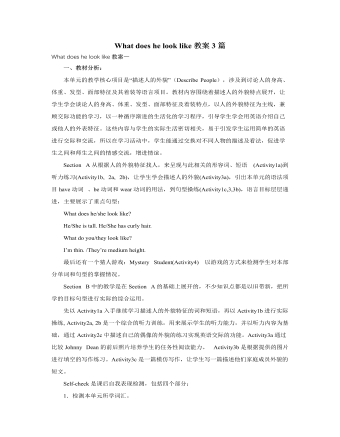
人教版新目标初中英语七年级下册What does he look like教案3篇
所需要用到的句子:Who is that?That is Jack. I like him.Why do you like him?I like him because he is interesting.Task 4: 设计理想中的人类Step one: 设计理想中的人类的外貌。把全班同学分成若干小组,学生可以边说边在纸上画出他们的模样。Step two: 设计理想中人类的性格。学生们可以把那些能描述性格的单词写在图画的旁边。Step three: 每组选出一名同学,其他同组同学提问,他作简单回答,并说明原因。所需用到的句子:What does he or she look like?He or she ...What is he or she like?He or she is ...Why?Because ...Task 5: 挑战性活动调查性格是天生的还是后天形成的,让每个同学回家去调查一下自己成长过程中性格是否有变化,具体是怎样的,为什么会这样? Teaching Aims:1. Enable students to have a general understanding of how to talk about people's physical appearance.2. Enable students to tackle some essential vocabularies and patterns about describing people. Provide them with necessary skills and methods.3. Create various chances for students to describe the persons they're familiar with, such as classmates, family members, teachers, idols, etc.
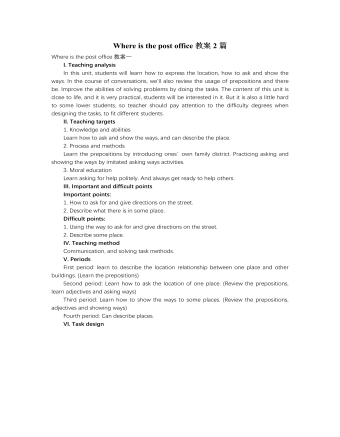
人教版新目标初中英语七年级下册Where is the post office教案2篇
Period 2 (3a----Section B 2c)Preview(Pre-task): Key points: What laAdd another information about their pen pals----their language on the cardnguage does she/he speak?She/He speaks....Does she/he have any brothers and sisters? Does she/he speak English?Preview(Pre-task): Add another information about their pen pals----their language on the cardKey points: What language does she/he speak?She/He speaks....Does she/he have any brothers and sisters? Does she/he speak English?Step 1 Revision1.Revisionand dictation of the new words 2.Revise the drills they learned yesterday.(by pairwork and grammar exercise)Step 2 Leading-inT has a conversation with one student. The conversation is following:---Do you have a pen pal?---Yes, I do.---What's your pen pal's name? ---His/Her name is....---Where is your pen pal from? ---He/She is from...---Where does he/she live? ---He/She lives in....---What language does he/she speak?He/She speaks...Write the new words on the Bb. They are following: EnglishChineseJapaneseFrenchStep 3 LearnLearn the new words with the whole class.Finish 3a with the students3b Pairwork T still does an example with one student Then the Ss practise in pairs. The example is following:--Curry Muray is my pen pal. He is from the United States.---What language does he speak?
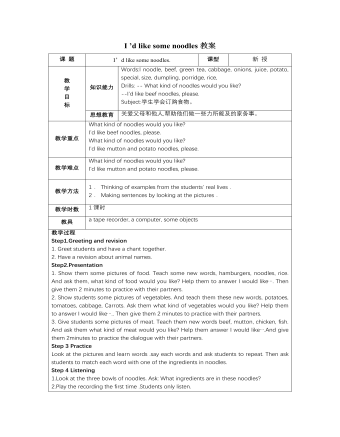
人教版新目标初中英语七年级下册I ’d like some noodles教案
教学过程Step 1: warming-up Sing a song---------“food and drink” Step 2: Revision1 Dictation2 Revise: What kind of noodles would you like?I’d like …What size bowl of noodles would you like?I’d like…Step 3: Presentation1 show pictures of food, ask students say the words.2 Students read the newspaper ad in 3a. Fill in blanks with words in the box. Then read the ad together, the teacher explains some difficult language points.3 Check the answers Step 4 PracticeAsk students to finish 3b in the same way according to 3a. Students read the short passage and fill in the blanks .At last, check the answers.Step 5 productionAsk students to write their own ad for dumplings, noodles, drinks, and other foods they know. Then ask students to read their partner’s ad. Then order food and drink from their partner.Step 6 Home workGroup work – make an ad about “food and drink”
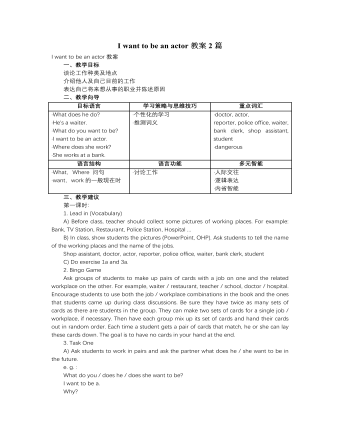
人教版新目标初中英语七年级下册I want to be an actor教案2篇
三、教学建议第一课时:1. Lead in (Vocabulary)A) Before class, teacher should collect some pictures of working places. For example: Bank, TV Station, Restaurant, Police Station, Hospital ...B) In class, show students the pictures (PowerPoint, OHP). Ask students to tell the name of the working places and the name of the jobs.Shop assistant, doctor, actor, reporter, police office, waiter, bank clerk, studentC) Do exercise 1a and 3a.2. Bingo GameAsk groups of students to make up pairs of cards with a job on one and the related workplace on the other. For example, waiter / restaurant, teacher / school, doctor / hospital. Encourage students to use both the job / workplace combinations in the book and the ones that students came up during class discussions. Be sure they have twice as many sets of cards as there are students in the group. They can make two sets of cards for a single job / workplace, if necessary. Then have each group mix up its set of cards and hand their cards out in random order. Each time a student gets a pair of cards that match, he or she can lay these cards down. The goal is to have no cards in your hand at the end.3. Task OneA) Ask students to work in pairs and ask the partner what does he / she want to be in the future.e. g. :What do you / does he / does she want to be?I want to be a.Why?Because it's (adj).B) Vocabulary: Section B, 1a4. Homework 1.2.
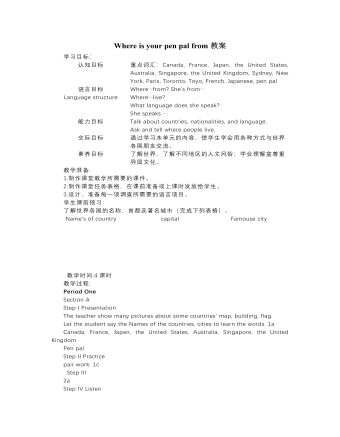
人教版新目标初中英语七年级下册Where is your pen pal from教案
2.1Match the country with the language.Step II Reading3a? let the students read the letter fast and answer the questions.? Let the students ask more questions about the letter as possible as the can.Step III Writing3b.Step IV. Pairwork2cStep V Listening2a, 2bStep V. HomeworkExercises book(1) P3Exercises book (2) P3Period FourStep I . Dictate the words and sentences in Unit1.Step II. Self-checkStep III. Check the answers for Exercises book in the unit.Step IV. Home workRevise and preparation for unit 2.教学反思:通过本单元的学习,学生基本可以谈论人们的国籍,居住城市及其所说的语言,通过书信方式去介绍自己并寻找笔友。但在涉及到国外的一些城市时,学生对这方面的知识相对欠缺,能介绍的城市并不多,也反应出学生课前预习不充分,这跟学生学习条件也有关,大多数学生无法通过网络获取所需信息。因此,在以后的教学中要多指导学生通过计算机网络获取信息,拓宽知识面。
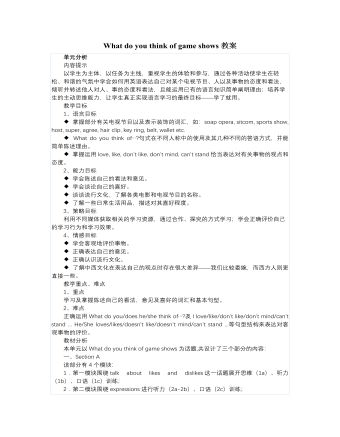
人教版新目标初中英语七年级下册What do you think of game shows教案
五、教学Section B-2c1. Pair work: What do you think of the belt/sunglasses/…? What does your father/mother/… think of your scarf/belt…?2. Group work(1). Teacher shows some different kinds of school uniforms (制服)and asks : “ What do you think of your school uniforms? If you have a chance to choose your school uniforms, what kind would you like to choose?”(2). Discuss in groups.(3).Get some Ss to report in class.说明:这一步旨在让学生运用已有的语言知识谈论对事物的看法和意见,并简单阐明理由,培养学生的主动思维能力和运用英语的能力。六、教学拓展调查电视节目的收视率任务:调查你周围的人对现在各种电视节目的反响。活动过程:1.教师布置任务,让学生调查周围的人(包括他的亲戚朋友和邻居)喜欢收看哪方面的电视节目。2.学生进行调查活动,运用本单元所学的句型What do you think of….? (Why?)What's your favorite game shows?What do you think of talk show?I doesn’t mind it.I like it.I love it.I can’t stand it.3.记录下排在前10位的TV Program,填写调查表,比较其收视率。

人教版新目标初中英语七年级下册Where did you go on vacation教案
句型: Where did you go on vacation? I went to summer camp.Did she go to Central Park?Yes,she did.No, she didn’t语法:一般过去时特殊疑问句、一般疑问句及肯、否定回答。课时安排4课时第一课时:Section A:la,1b,lc,2a,2b,2c 第二课时:Section A:3a,3b,4第三课时:Section B:1,2a,2b,2c第四课时:Section B:3a,3b,3c,4 and Self Check第一课时教学目标掌握描写假期生活的形容词。假期里自己所做事情的简单表达。谈论假期做的事情及当时情况。谈论假期时旅游的天气,旅游者以及食物等。教学过程一、导入播放一首英文歌曲:Let’s travel 说明:通过让学生听节奏欢快迪斯尼英语歌曲Let’s travel.引入本节课谈论的话题vacation and travel. 让歌曲使学生的思维活跃,增强课堂气氛,激发学生提高学习英语的兴趣。T:How is the trip ?Ss : It’s pretty good/ happy/exciting /relaxing/busy/dangerous/ fantastic说明:这个问题是为了操练形容词。建议让多个Ss作答。鼓励他们用不同的形容词。上述个别形容词本应在第二课时中出现,但可以在warming-up中第一次非正式出现。这些形容词也可在老师的评价语中适时出现,以加深学生对词汇的印象。
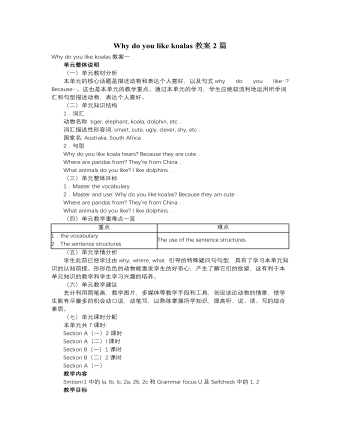
人教版新目标初中英语七年级下册Why do you like koalas教案2篇
单元整体说明(一)单元教材分析本单元的核心话题是描述动物和表达个人喜好,以及句式why do you like…? Because…。这也是本单元的教学重点。通过本单元的学习,学生应能较流利地运用所学词汇和句型描述动物,表达个人喜好。(二)单元知识结构1.词汇动物名称 tiger, elephant, koala, dolphin, etc.词汇描述性形容词: smart, cute, ugly, clever, shy, etc.国家名: Australia, South Africa2.句型Why do you like koala hears? Because they are cute.Where are pandas from? They're from China.What animals do you like? I like dolphins.(三)单元整体目标1.Master the vocabulary2.Master and use: Why do you like koalas? Because they am cute.Where are pandas from? They're from China.What animals do you like? I like dolphins.(四)单元教学重难点一览(五)单元学情分析学生此前已经学过由why, where, what 引导的特殊疑问句句型,具有了学习本单元知识的认知前提。形形色色的动物能激发学生的好奇心,产生了解它们的欲望,这有利于本单元知识的教学和学生学习兴趣的培养。
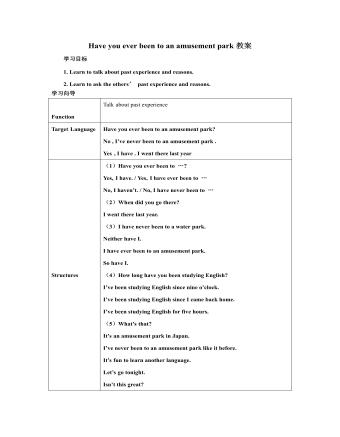
人教版新目标初中英语八年级下册Have you ever been to an amusement park教案
(1)Have you ever been to …? Yes, I have. / Yes, I have ever been to …No, I haven’t. / No, I have never been to …(2)When did you go there? I went there last year. (3)I have never been to a water park. Neither have I. I have ever been to an amusement park. So have I. (4)How long have you been studying English? I’ve been studying English since nine o’clock. I’ve been studying English since I came back home. I’ve been studying English for five hours. (5)What’s that? It’s an amusement park in Japan. I’ve never been to an amusement park like it before. It’s fun to learn another language. Let’s go tonight. Isn’t this great?space museum, amusement park, water park, South America, Peru, Holland, European culture, tour guide, flight attendant, musical instrument, more than, be from, get to, take lessons, neither, discover, graduate, change
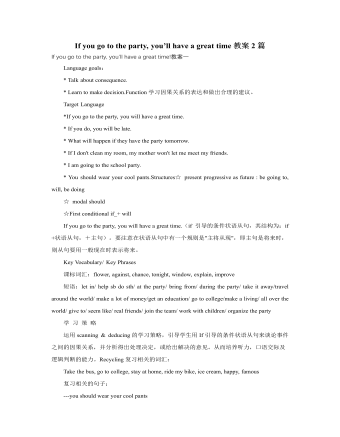
人教版新目标初中英语八年级下册If you go to the party, you’ll have a great time教案2篇
区分宾语从句、定于从句和状语从句宾语从句和状语从句,都叫做主从复合句。宾语从句主要是中考必考的,是初中阶段必掌握的从句,宾语从句主要是掌握三要素,所谓宾语从句,就是宾语在主从复合句当中充当宾语的一个句子,叫做宾语从句。主句的谓语动词是及物动词,后面如果是词或者是短语的话,是简单句,如果是句子的话,肯定是宾语从句。I know that he good at English.就是宾语从句,三要素,一要素是要注意连词,连词一共学了三类连词,一类连词是that口语当中可以省略,就像刚才说的那一句,I hear he is good at English.还有疑问代词、疑问副词,how where when,疑问代词、疑问副词。还有一类连词weather是否的意思,不是状语从句当中的如果,这一定要和如果区分开,这是是否。I don't know if he interested at English。宾语从句要注意if是连词。第二要素是语序,要用陈述举语序。比如说你家有几口人,我们都说How many people are there in you family?但是这是简单句,一旦说成宾语从句,你可以告诉我你家有几口人吗?Could you tell me how many people there are in you family ?
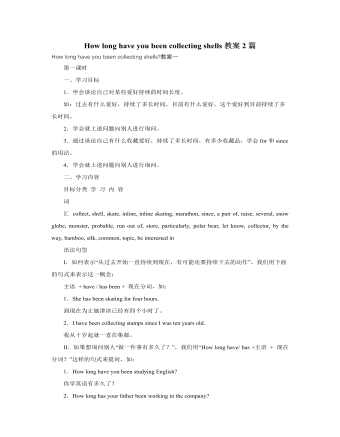
人教版新目标初中英语八年级下册How long have you been collecting shells教案2篇
Step Ⅱ Show the new words on the screen and teach the new words. Read the new words to students and ask them to repeat.Step Ⅲ 3aThis activity introduces new vocabulary and provides reading practice using the target language.In this activity first look at the four pictures.T: What can you see in the pictures?Ss: Four snow globes.T: Right. There are four snow globes in the pictures. And what are they?Ss: They are a monster, two polar bears, two penguins and a birthday cake.Write these words on the blackboard: snow globe; monster; polar bear; penguin and birthday cake. Read them to the class and ask students to repeat each one. Make sure students understand each word.Use a computer to show the E-mail message on the screen and read the message to students.Get students to read the e-mail on their own, and then draw lines connecting each snow globe and its description.Correct the answers.AnswersA line should connect each snow globe picture with the words that describe it in the letter.Step Ⅳ 3bThis activity provides writing practice using the target language.First review Activity 2a on Page 47.Then ask students to complete the message according to Activity 2a.Some partial sentences are given to students. Write about one person's collection.When students work, walk around the room checking the progress and offering help as needed.When they finish, ask some students to read their messages to the class.
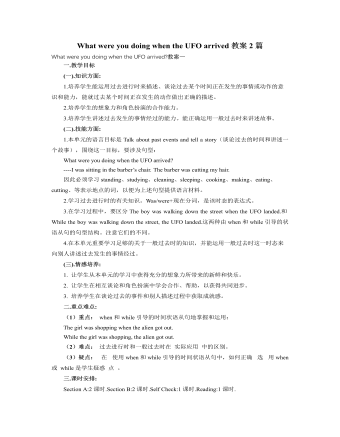
人教版新目标初中英语八年级下册What were you doing when the UFO arrived教案2篇
(一).知识方面: 1.培养学生能运用过去进行时来描述、谈论过去某个时间正在发生的事情或动作的意识和能力,能就过去某个时间正在发生的动作做出正确的描述。 2.培养学生的想象力和角色扮演的合作能力。 3.培养学生讲述过去发生的事情经过的能力。能正确运用一般过去时来讲述故事。 (二).技能方面: 1.本单元的语言目标是Talk about past events and tell a story(谈论过去的时间和讲述一个故事),围绕这一目标,要涉及句型: What were you doing when the UFO arrived? ----I was sitting in the barber’s chair. The barber was cutting my hair. 因此必须学习standing、studying、cleaning、sleeping、cooking、making、eating、cutting、等表示地点的词,以便为上述句型提供语言材料。2.学习过去进行时的有关知识。Was/were+现在分词,是该时态的表达式。 3.在学习过程中,要区分The boy was walking down the street when the UFO landed.和While the boy was walking down the street, the UFO landed.这两种由when和while引导的状语从句的句型结构。注意它们的不同。





















